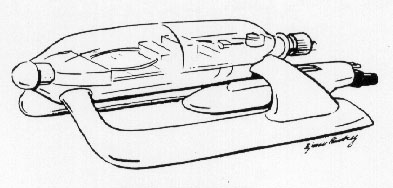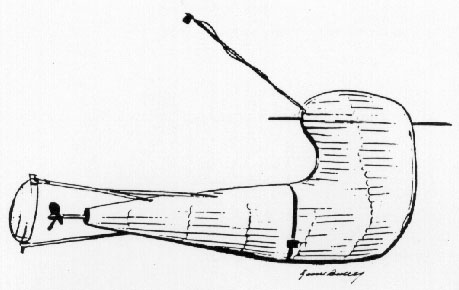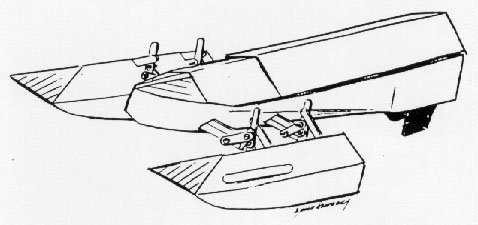
This paper presents a new course <<Creative Design>> also called <<The Ordeal of Archimedes>>.The objective of the course is to improve the students understanding of the nature of design at an early stage in the M.Sc. study. The core of the course is a project assignment of designing and building a radio controlled vessels in teams of four students, and lectures are only a minor element in the pedagogic approach. Instead of a written exam the students make a poster, do a presentation, and perform a race between the vessels in the Ocean Basin.

The idea of The Ordeal of Archimedes was conceived at the Institute of Marine Design in 1992 as a design learning strategy. The intention is to contribute to that the students early in the study learn to utilise knowledge and skills in situations that demand creative efforts. The engineering study programs at NINU1 are by tradition based on science, and creativity and engineering are almost absent. In the curriculum in the first part of the study the students are introduced to different basic subjects which they at that time are unable to relate to practical problems and see no use of, and thus the study motivation becomes very low.
The Ordeal of Archimedes was for the first time run by a team of research assistants as a pedagogical experiment financed by the industry. The idea was to train second year students in design, and to increase their study motivation. Due to the fact that it was run completely independent of the ordinary study curriculum, some of the methods used were far away from traditional teaching. The response from the students, however, was so positive that it was decided to develop the idea further.
During a period of 5 years, The Ordeal of Archimedes has evolved from being a pedagogical developmental project into the course <<Creative Design>> (B. Sortland and A. Gulbrandsen 1997). A number of different elements have been tested and implemented to make the course complete and more structured. A major feedback in this continuous optimising process have been obtained through teaching assistants who have just finished the course. It has also been a tough fight to make the course accepted by academic colleagues, and further included in the course catalogue.
The course is voluntary and is open to a limited number of second year students from the Faculty of Architecture and the Faculty of Marine Technology. It requires more resources than the average course due to extensive use of laboratories and the need for five teaching assistants. The course has, however, survived because of the massive positive response from the students, giving a significant increase in study motivation. Further there is a growing need within the engineering study for new educational ideas and methods.
In The Ordeal of Archimedes the students are trained in acquiring their own knowledge, what is becoming more and more important. The course is to a far extent what we call problem based learning, because it is based on the sarne ideas. The characteristic elements of The Ordeal of Archimedes that are not included within problem based learning are the team processes, the practical testing, and the evaluation.
The Ordeal of Archimedes has received much attention for its untraditional methods. Glimpses from the first completion have been shown by the Norwegian Public Broadcasting in the TV programme "Schrødinger's cat", and the course was in 1994 awarded a prize by the Norwegian Society of Chartered Engineers (NIF) for pedagogical pioneer work.
Parallel, but independent of the development of The Ordeal of Archimedes, the engineering study programme at NTNU has been under evaluation. In a strategy report (NTH 1993) different issues are pointed out in order to improve the study:
The study should give substantial technological competence as a basis for life-long learning. Basic subjects within natural science and technology should be emphasised. A strengthened relation between basic and applied subjects should increase motivation for study and overall understanding of the students. Technology should to be placed in a social context, and the proportion of non-technological subjects should be increased.
The Ordeal of Archimedes is to a high degree developed along the lines listed above, and several of the thoughts were implemented right from the beginning. Through The Ordeal of Archimedes it has been documented that substantial improvement of the engineering study can be obtained by changes in study methods. At the moment a major revision of the engineering study programme at NTNU is planned according to the recommendations above.
The study philosophy of The Ordeal of Archimedes is different from traditional science study tradition. Each culture can be defined by a basic statement:
1. This is what you should learn.
The science study tradition is based on the assumption that the students know nothing about the
subject when they enter a study, and that they need to learn a lot of theory before they can start
solving problems. What the student should learn is strictly defined.
2. What can we learn from this?
In the culture of The Ordeal of Archimedes it is realised that the students even at
the very beginning
of the study, know enough to start solving problems. The teachers are mainly arranging the work
and stimulating the students to collect knowledge, draw their own conclusions, and thus develop
their intellect. In this culture it is not in detail defined what the students should learn.
The Ordeal of Archimedes is developed within culture 2, even though there is some specific knowledge the students should learn. They should learn about buoyancy, resistance and stability among other subjects of vital importance to a marine engineer. It is therefore important for the teacher to chose exercises in the way that all the needed subjects are covered. When entering the course the students do not know enough to be able to make the optimum vessel based on given criteria, but through the process of testing they will develop the needed knowledge. The race at the end of the course is only a <<catalyser>> in the process.

The scope of The Ordeal of Archimedes is to give the students a basic understanding of the design process from the generating of ideas to the completion of a prototype. Through this process the students are given a basic understanding of creative processes, of the connection between function and form, and the connection between different physical limitations.
The work takes place in multidisciplinal teams consisting of students of architecture and marine technology. This creates possibilities for training in teamwork and communication, and makes the students take more responsibility for their learning process. The course is carried through with a minimum of lectures.
The course lasts eight weeks in the fall term, and starts with two fully working days over a weekend. Through this weekend team processes and various human aspects associated with creativity are introduced Later themes like problem definition, understanding of form, use of drawings in product development, and presentation of concepts and products are covered. Further guidance in a number of issues in design and marine technology are given.
The course ends with a presentation of the vessels and a competition in the Ocean Basin. The work is evaluated by a jury of three professors. The grading in the course is pass/not pass
During the first weekend creativity, communication and team interaction are introduced through the work with a number of tasks. Simultaneously the permanent teams are formed, and united through work and team contracts. The work takes place in a large room without furniture and with a wooden floor. Throughout the weekend different kinds of music is used to stimulate and activate the students as part of the work.
The session starts with the students being known to each other through a process of introducing themselves, and continues with different exercises on team interaction, ending up by establishing the permanent teams in which the work for the rest of the course will be performed. The first creative exercise in the teams is to develop a logo for the course, and a poem to go with it. Through a process of presentation and election the best idea/concept is chosen which later is printed on T-shirts to all the participants. At the end of the first day the teams give a summary of the day by mimic and dance.
The next day proceeds by different creative exercises. A major activity is to introduce the student to the physics of buoyancy, stability and resistance, and to demonstrate the use of a model tank as a tool in hull form design. From a block of divinycell (a plastic foam) a vessel is to be formed that has low resistance, good directional stability, and the capability of carrying a given weight. Each of the teams are to develop a vessel, the overall best vessel is selected through a contest, and the team awarded a prize.
After the rules are presented, the students have 30 minutes for planning, and further one hour in a workshop to form the vessel. The time available is by experience short and contributes to a hectic activity. On purpose no corrections are given during the process other than answering questions, because it is believed that the students learn even more from failing than being guided to a safe success. Thus several of the vessels capsize during the contest due to insufficient stability. A list of the results is produced, and the whole performance is filmed on video.
As an end to the activities of the weekend, the project assignment that the teams are going to work with throughout the rest of the course are presented in the form of a dream. Each team is to develop a radio-controlled vessel capable of performing a race, and it is to be built according to specific criteria. The criteria are altered every year, and is kept secret until the time of presentation. The evaluation criteria are given as part of the assignment.
After the first weekend, one proceeds by reflecting on the activities and exercises that have been completed. The question: <<What can we learn from this?>> is asked, and the students are made aware of the educational culture of The Ordeal of Archimedes. In particular it is focused on the results from the competition in the towing tank, by gathering the students around the divinycell vessels and the list of results, in order to discuss the performance of each design. First at this stage the students meet theory about resistance and stability. Now they have a strong need for an explanation of their success or disaster, and they have already started to understand the physics involved. At the end of the lecture or colloquium the video from the competition, showing the performance of each vessels, is shown to strengthen their knowledge.
The development of the divinycell vessels is in fact a small version of the project assignment, and have introduced the students to the study method of The Ordeal of Archimedes.
The teams are gradually left to themselves during the work on the assignment. The teams are led by the help of milestones through the separate phases of generating ideas, designing, building and testing. In the course of the process different subjects relevant for the work with the vessels are dealt with. Focus is on the process of development in the teams, thus the major guidance is given as individual feedback within the teams by the teaching assistants and the lectures at the faculty.
After the first phase of generating ideas and developing concepts, the teams have to present their concepts before the jury in an auditorium. This is done to give them feedback on their designs before they start building, and at the same time practice in presentation After the concept presentation there are time for redesign before the building of the vessels starts.

Through the process of building and testing, a number of problems are to be solved. Experience has shown that team contracts and a formal log of the work has a good effect in preventing the teams from falling apart. One week before the final race a first test in the Ocean Basin is allowed, where the students for the first time can test their vessels under real conditions. Normally different problems are brought to attention, and then there are one week to solve the problems.
During the last week before the race the work shift focus from building and testing to development of the exhibition and preparations for the presentation. The purpose of the exhibition is to move some of the activity away from the field of marine technology. To make a good setting for the creativity needed in this phase, and to help the students to see their vessels from an other point of view, the teams are at this stage asked to give their vessels a name and poem to go with it.
The exam in The Ordeal of Archimedes starts with the opening of the exhibition where the vessels are presented together with name, drawings and poem. Further the students presents their vessels and argue for the design in an auditorium before the jury, and finally the competition in the Ocean Basin takes place. All these three elements counts in the evaluation, and is open to the public. The exhibition strongly contributes to give the subject a profile, and to give the work of the students common acceptance, which also provides a strong motivation. The race in the Ocean Basin (80 x 50 m) draw a lot of attention, and around 100 spectators are common.
After the presentation and the competition, the jury gives a verbal assessment on the design of each vessel in a dialogue with the students, before the winner is announced. A special innovation prize is also awarded.
In The Ordeal of Archimedes the students are collecting knowledge through the process of designing, building and testing a radio controlled vessel as team work. A race at the end of the course is a strong motivational factor. The result is that the students are more active and acquire knowledge of the subject matter more extensively than in traditional courses, giving an increased study motivation for the rest of the study.
Future engineers must have the ability to adapt to new conditions and developments. It is therefore important that the students learn to take more responsibility for their own learning process. Work in multidisciplinal teams is getting more and more usual in professional life. The ability to cooperage and communicate is going to get more important.
NTH (1993). <<Strategy report, the engineering study programme at NTH (Virksomhetskomitéen for sivilingeniørstudiet ved NTH)>>. (In Norwegian.)
B . Sortland and A. Gulbrandsen ( 1997). <<The Ordeal of Archimedes>> in Total language and learning (Helhetsspråk og læring) edited by A. Gulbrandsen og J. Forslin, Tano Aschehoug, Oslo, in press. (In Norwegian.)
1 The Norwegian University of Science and Technology (NTNU) was established on 1 January 1996. It replaces the University of Trondheim which included the Norwegian Institute of Technology (NTH).